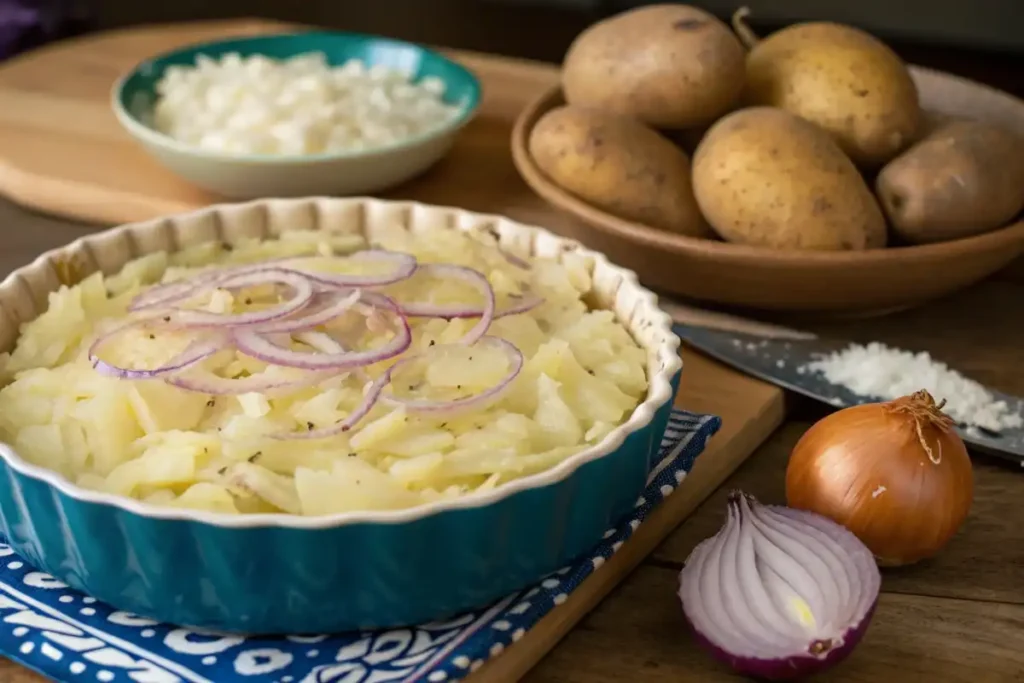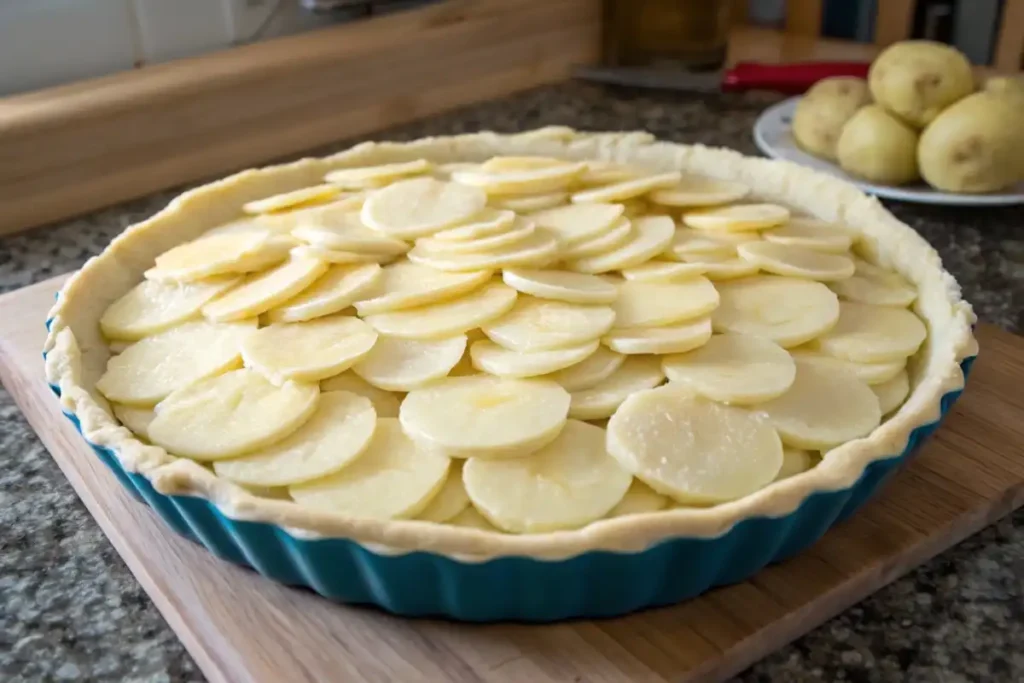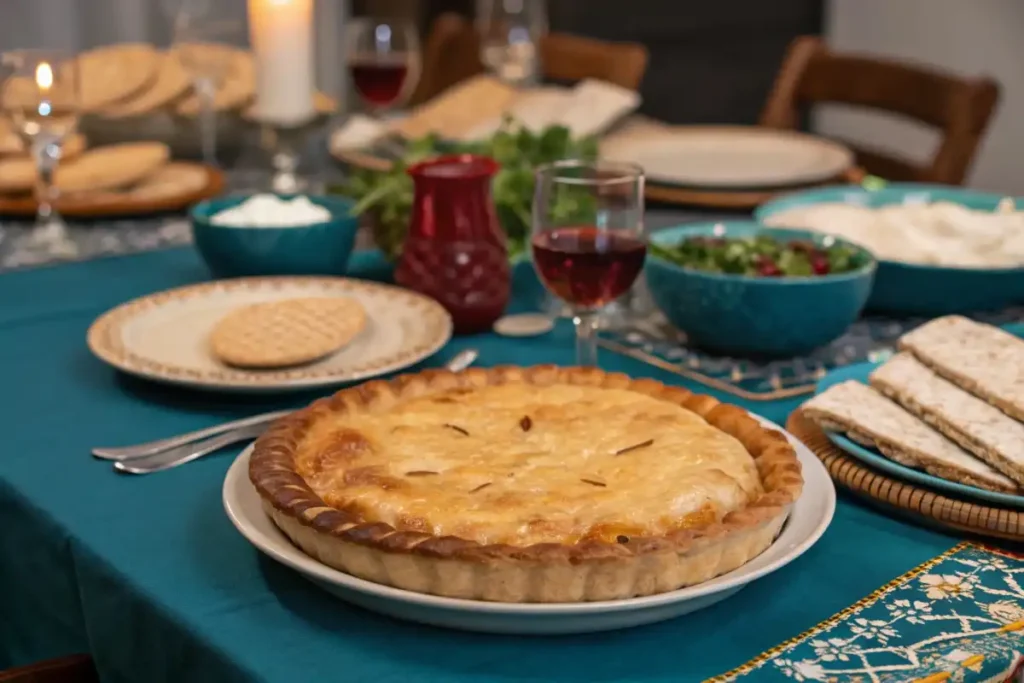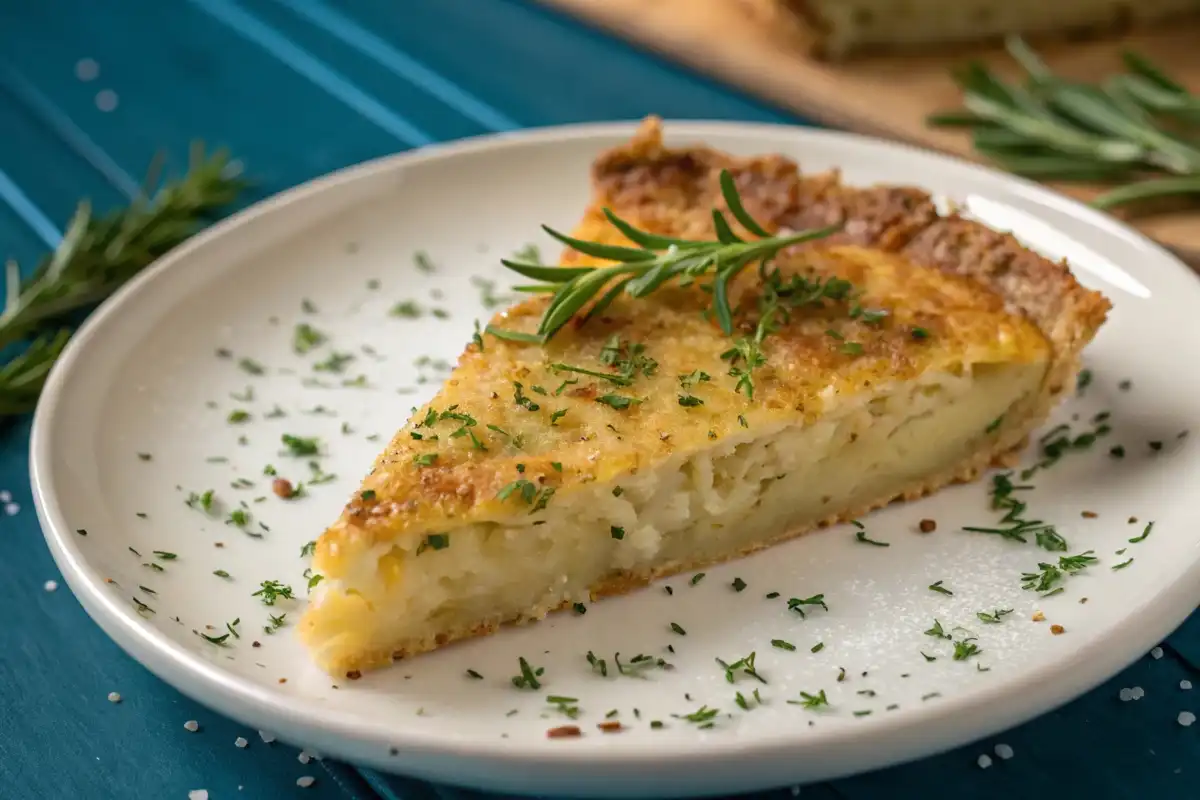At the present time, many families seek creative ways to celebrate Passover. One dish that truly brings flavor and tradition together is Passover potato pie. This comforting recipe embraces old-world customs while introducing modern techniques. In fact, this dish offers the hearty potato goodness associated with Ashkenazi traditions, combined with the familiarity of pie-like structures beloved in American cuisine.
In addition, Passover potato pie stands out because it uses simple, staple ingredients that fit the dietary rules of this important Jewish holiday.
Potatoes remain a key ingredient during Passover, because they are both kosher and permissible.
Therefore, this dish delights guests of all ages. Furthermore, it can easily serve as a main course for vegetarians or as a comforting side next to roast chicken or fish. This Passover potato pie truly merges old traditions and new inspirations.
Why Passover Potato Pie Deserves a Spot at Your Seder
Passover symbolizes freedom and renewal. The holiday’s culinary traditions reflect the journey of the Jewish people and the resilience of their culture.
Passover potato pie contributes to this tapestry of flavors.
In contrast to more common Passover staples, such as matzo ball soup or brisket, this dish adds a fresh take on the classic potato kugel, elevating it into a visually appealing “pie” form.
Furthermore, cooking with potatoes aligns beautifully with Passover guidelines because potatoes are not chametz.
Many Passover meals rely heavily on produce that respects the holiday’s limitations. For instance, potatoes are filling, versatile, and gluten-free. Therefore, Passover potato pie fits perfectly into a kosher-for-Passover menu.
Additionally, this dish tastes delightful warm or at room temperature, making it ideal for large gatherings and Seder celebrations. In the meantime, you can prepare it in advance, saving time and effort before your guests arrive.
The Cultural Roots of Passover Potato Pie
The roots of Passover potato pie draw inspiration from the European Jewish diaspora. In Eastern Europe, the Ashkenazi community embraced potatoes as a primary source of sustenance.
Because of stringent holiday restrictions, families replaced their usual flour-based foods with versatile potatoes. Eventually, creative cooks fashioned potato-based dishes that transcended simple boiled potatoes.
They shredded or mashed them, added eggs, and seasoned them to yield dishes reminiscent of kugels and pies.
Over time, the potato-based kugel gained a strong foothold in many Jewish holiday menus.
To demonstrate its significance, consider how potato kugel frequently appears on Shabbat and Passover tables. By shaping it into a pie, you bring a slight modern twist. In addition, this shape allows for a lovely presentation when sliced and served. Hence, Passover potato pie respects tradition, yet pleases contemporary palates seeking variety and flair.
Key Ingredients for the Perfect Passover Potato Pie
To create an unforgettable Passover potato pie, focus on quality ingredients. In contrast to overly complicated recipes, this dish shines with a handful of simple components. Consider the following key ingredients:
- Potatoes: Use starchy potatoes, such as Russets or Yukon Gold, because they produce a creamy texture.
- Onions: Onions add subtle sweetness and depth. Grating or finely chopping them enhances their flavor.
- Eggs: Eggs bind the mixture and give the pie structure and fluffiness.
- Oil or Schmaltz (Rendered Chicken Fat): A small amount of fat enhances flavor and crispness on top. In many traditional recipes, schmaltz is popular. However, vegetable oil works perfectly well, especially for a vegetarian-friendly version.
- Herbs and Seasonings: Fresh parsley or dill brighten the dish. Kosher salt and ground black pepper offer a balanced taste. A pinch of garlic powder or onion powder may also lend complexity.

Step-by-Step Recipe for Passover Potato Pie
Ingredients (Serves about 8)
- 3 pounds of Russet or Yukon Gold potatoes, peeled and shredded
- 2 medium onions, peeled and grated
- 4 large eggs, lightly beaten
- 1/4 cup vegetable oil (or schmaltz), plus extra for greasing the baking dish
- 2 tablespoons fresh parsley, chopped (optional)
- 1 tablespoon fresh dill, chopped (optional)
- 1 teaspoon kosher salt (adjust to taste)
- 1/2 teaspoon ground black pepper (adjust to taste)
- A pinch of garlic powder or onion powder (optional)
Equipment
- A 9-inch pie dish (preferably glass or ceramic)
- A large mixing bowl
- A grater or food processor
- A clean kitchen towel or cheesecloth for squeezing out moisture
- A whisk
- Measuring cups and spoons
- A spatula or wooden spoon
Instructions
Step 1: Prepare the Potatoes
First, peel the potatoes and shred them using a grater or food processor. In addition, grate the onions. Place the shredded potatoes and onions in a clean kitchen towel or cheesecloth. Then, squeeze out as much moisture as possible. Removing excess water ensures a crisp and flavorful Passover potato pie.
Step 2: Mix the Ingredients
Next, transfer the drained potato-onion mixture into a large bowl. In a separate bowl, whisk the eggs until blended. Pour the eggs over the potato mixture. Add the oil, fresh herbs (if using), salt, pepper, and optional seasonings. Stir well until combined. The mixture should hold together slightly, but not appear too wet.
Step 3: Assemble the Pie
Grease your pie dish with a thin layer of oil. Press the potato mixture evenly into the dish, smoothing the top with a spatula. In addition, try to create a slight dome shape in the center to prevent uneven cooking.
Step 4: Bake to Perfection
Preheat your oven to 375°F (190°C). Place the pie dish on the middle rack and bake for about 60 to 70 minutes. In contrast to a typical kugel, a Passover potato pie resembles a savory potato “cake.” Check periodically. The top should form a golden-brown crust, and a knife inserted in the center should come out clean.
Step 5: Rest and Serve
Remove the Passover potato pie from the oven and let it rest for about 10 to 15 minutes. This resting period allows the flavors to meld and the pie to firm up, ensuring neat slices. Cut into wedges and serve warm. Because the pie retains its flavor and texture well, it may also be enjoyed at room temperature.

Serving Suggestions and Menu Pairings
To create a balanced Passover meal, serve Passover potato pie alongside other holiday favorites:
- Main Dish Pairings:
- Roasted chicken with fresh herbs
- Slow-braised brisket (ensure it’s kosher for Passover)
- Oven-baked salmon seasoned with lemon and dill
- Side Dish Inspirations:
- A light salad of mixed greens, cucumbers, and cherry tomatoes
- Roasted asparagus with olive oil and lemon zest
- Matzo ball soup as a soothing starter
In addition, consider a fruit compote or fresh berries as a bright, sweet finish. This helps counterbalance the richness of the pie. Furthermore, offering a variety of textures and flavors ensures that your guests enjoy an exciting, complete feast.

Tips for Success
Crafting an exceptional Passover potato pie requires attention to detail. Hence, consider these tips:
- Remove Excess Moisture:
For instance, thoroughly squeezing out moisture from the potatoes and onions helps achieve a crisp, well-structured pie. - Season Generously:
Potatoes benefit from ample seasoning. Therefore, add salt and spices with care, tasting as you go. - Quality Ingredients Count:
In addition, choose fresh, firm potatoes and flavor-rich herbs. This simple step elevates the entire dish. - Make Ahead:
In contrast to some Passover dishes that must be served fresh, this pie can be prepared in advance. Bake it the day before and reheat gently. Because Passover celebrations can be hectic, planning ahead saves time.
Nutritional Information for Passover Potato Pie
Below is approximate nutritional data per serving (one slice, serving about 8 slices per pie). These values may vary depending on exact ingredients and brands used.
| Nutrient | Amount per Serving |
|---|---|
| Calories | ~210 kcal |
| Carbohydrates | ~28 g |
| Protein | ~5 g |
| Fat | ~9 g |
| Saturated Fat | ~1.5 g |
| Dietary Fiber | ~3 g |
| Sodium | ~260 mg |
| Potassium | ~600 mg |
| Vitamin C | ~10% DV |
| Iron | ~6% DV |
Note: Percent Daily Values (DV) are approximate and based on general guidelines.
Variations and Adaptations
Passover potato pie is adaptable. Because dietary needs vary, consider these variations:
- Vegetarian or Vegan:
To make the dish vegan, replace eggs with a Passover-approved vegan egg substitute, if available. In addition, use vegetable oil instead of schmaltz. - Fresh Herbs and Spices:
Add fresh chives, thyme, or even rosemary. Further enhancing the flavor profile keeps the dish interesting. - Extra Vegetables:
Grate some carrots or celery root and mix them into the potato base. For example, these extra vegetables add complexity without violating Passover rules. - Cheese Topping (If Kosher for Passover and Dairy Allowed):
In some kitchens, a sprinkle of kosher-for-Passover cheese on top might be permitted, adding a golden crust.
Comparing Passover Potato Pie to Potato Kugel
Potato kugel is a beloved staple in Jewish cuisine. However, Passover potato pie takes this concept and gives it a charming twist. In essence, the flavor profiles are similar, but the presentation differs. A kugel is typically baked in a rectangular or square dish. In contrast, the pie shape offers a more festive look, perfect for special occasions.
Additionally, potato kugel often has a fluffier interior, while Passover potato pie focuses on a crisp crust and a sliceable consistency. The pie format also encourages creative plating. Serve wedges garnished with fresh herbs or a dollop of charoset on the side for a sweet-sour contrast.
Storage and Reheating Tips
Because Passover gatherings can stretch over multiple days, proper storage is key:
- Refrigeration:
Cover leftover pie and refrigerate it for up to 3 days. Before serving again, reheat slices in a 350°F (175°C) oven until warmed through. This method preserves texture better than microwaving. - Freezing:
Freeze leftover slices by wrapping them individually and placing them in a freezer-safe container. Thaw overnight in the fridge. Eventually, reheat in the oven. Though texture may soften slightly, the flavor remains appealing.
Frequently Asked Questions (FAQs)
Can Jews eat potatoes during Passover?
Yes, Jews can eat potatoes during Passover. In fact, potatoes are a staple because they are not chametz. Many traditional Passover recipes rely on potatoes to create filling, flavorful dishes. Therefore, a Passover potato pie is an excellent choice…
What is potato kugel made of?
Potato kugel typically consists of shredded potatoes, onions, eggs, and oil. Sometimes, cooks add seasonings like salt, pepper, and herbs. The mixture bakes into a soft, savory casserole that complements a variety of Passover and Shabbat meals…
Can you eat kugel on Passover?
Yes, you can enjoy potato kugel during Passover. Since potato kugel contains no chametz, it is often served at Seder meals. Passover potato pie, a variation of kugel, also fits perfectly into a holiday menu…
What is white potato pie made of?
White potato pie may refer to a sweet or savory dish. In a savory context, it often includes shredded or mashed white potatoes, eggs, butter or oil, and seasonings…
Additional FAQs
Is this recipe gluten-free?
Yes, Passover potato pie is naturally gluten-free since it contains no wheat. Potatoes are the main base, and no grains are included. This makes it suitable for people who avoid gluten.
Is it possible to use sweet potatoes?
Yes, you can experiment by using sweet potatoes. However, the flavor and texture will differ. Sweet potatoes yield a sweeter, denser pie, which may not taste as traditional. In addition, keep in mind that sweet potatoes may need slightly different seasoning.
How can I ensure a crisp top?
For a crisp top, brush a small amount of oil over the surface before baking. Furthermore, baking uncovered helps develop a lovely brown crust.
Can I add other root vegetables?
Yes, you can incorporate other root vegetables like parsnips or turnips. This adds layers of flavor. However, always ensure that these ingredients are kosher for Passover and that their textures blend well with the potatoes.
Can I serve this dish with a sauce?
Certainly. For instance, serve it with a dollop of applesauce or a side of tangy horseradish sauce. Sauces add brightness and create flavor contrasts.
Is Passover potato pie a main dish or a side dish?
It can be both. Serve it as a main dish for a vegetarian guest or as a side alongside meat or fish. Its versatility makes it a favorite on the Passover table.
Conclusion to Passover Potato Pie
In conclusion, Passover potato pie offers a delicious way to celebrate tradition while embracing innovation.
Because this dish honors the holiday’s culinary roots and respects dietary guidelines, it has become a must-have addition to many Passover menus.
Moreover, its simple ingredients and adaptable nature ensure that even novice cooks can find success and impress their guests.
To sum up, remember that quality ingredients, proper seasoning, and patience produce an exceptional Passover potato pie. Eventually, this dish may become a cherished family tradition, gracing your Seder table year after year.
Enjoy the comforting flavors and the symbolic connection to generations past.
